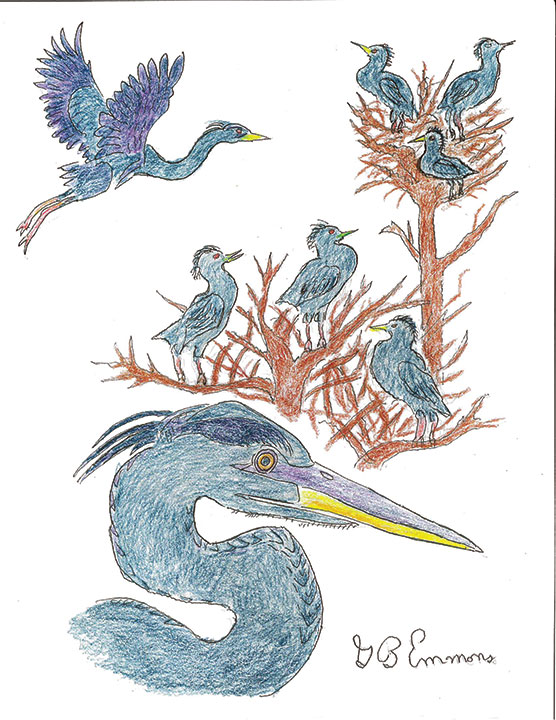The Great Blue Heron wading in shallow shoreline waters makes a lasting impression on every bird watcher.
The skulking Heron cautiously takes one step at a time with head and neck drawn back in a serpentine shape, ready to spring forward to spear and retrieve an innocent target in the flash of a single gulp. Then the Heron, having riled up the solitude of the peaceful water, often takes wing to a more promising location while stretching out a 6-foot frame with long wading legs trailing out far behind as in my illustration.
The Great Blue Heron is right at home in both fresh and saltwater habitat and in either will eat a wide menu of anything found there within striking distance. The inland earthly selection includes terrestrial small mammals, reptiles, toads, insects and even young birds.
The building of inland beaver dams has created additional shallow wading ponds and stream-side pools far and wide in parks and reservations over most of New England.
Great Blue Herons nest mainly in trees, often taking advantage of existing structures such as artificial platforms built for ospreys. Males, like ospreys, collect most of the material by gathering sticks, moss, reeds and mangrove salt grass to be presented to the female when she arrives.
In just a short time, she will be able to finish a platform several feet across and 4 feet in length. However, her signature construction design often builds a colony of vertical nests, each higher than the other and similar to man-made apartment living, also in my illustration.
The latest North American heron survey estimates a continental population of 83,000 breeding birds found all over America. They can be seen all summer long but in autumn statistics prove they migrate much farther than most other waterfowl.
Great Blue Herons have somehow become a local symbol of a healthy water condition almost as elite as a Bald Eagle or osprey. The Algonquin freshwater Indian name for the Heron is “Spirit of the water,” and their native observation seems to capture a kindred connotation for you in my article as a sacred symbol similarly interpreted while bird watching.
By George B. Emmons
